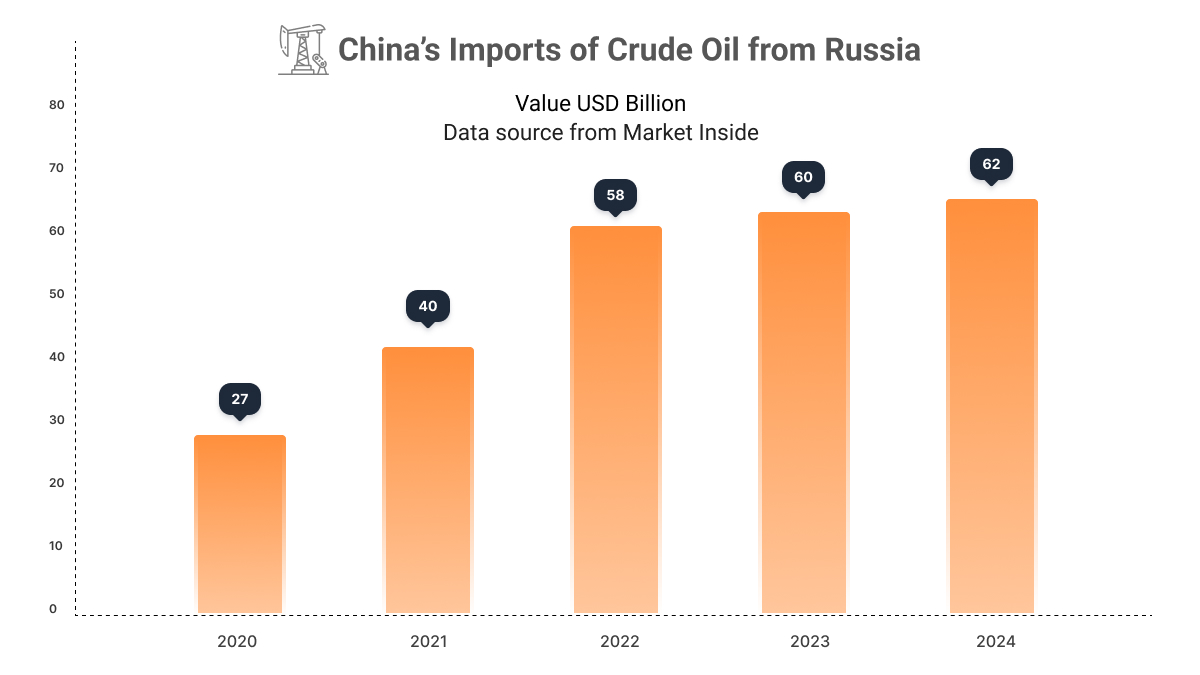Despite mounting diplomatic pressure and the U.S.-China deal, China has continued to import significant volumes of oil from Russia and Iran. This ongoing trade reflects Beijing’s determination to prioritize energy security and economic interests over Western geopolitical concerns. As tensions rise between major global powers, China’s actions highlight a shifting international order in which traditional alliances and sanctions are increasingly tested by pragmatic national strategies.
US and Chinese officials may be able to settle many of their differences to reach a trade deal and avert punishing tariffs. Still, they remain far apart on one key issue: the US demand that China halt its purchases of oil from Iran and Russia. Market Inside provides in-depth insights of China’s imports of crude oil from Russia and Iran.
China’s Imports of Oil from Russia
Here’s an updated breakdown of China’s crude oil imports from Russia and Iran from 2020–2024:

| Year | Value USD Billion |
| 2020 | 27 |
| 2021 | 40 |
| 2022 | 58 |
| 2023 | 60 |
| 2024 | 62 |
China’s Imports of Oil from Iran
Estimating Iran’s oil exports to China is more challenging. Chinese customs stopped reporting Iranian origin separately from mid‑2022 due to widespread sanctions and re‑labelling. However, external tank‑tracking and policy analyses provide a broader perspective:
- 2020: Iran accounted for ~ 3% of China’s crude imports (~$7.1 B)
- 2021–2023: Reports indicate China (with India) bought roughly $90 billion worth of Iranian oil since early 2021, most of which flowed to China via intermediaries and shadow transactions.
- 2024: China remained the dominant buyer (~77% of Iran’s exports), totalling approximately $29 billion in crude revenues to Tehran.
The response is notable at a time when both Beijing and Washington are signaling optimism and goodwill about reaching a deal to keep commercial ties between the world’s two largest economies stable, after climbing down from sky-high tariffs and harsh trade restrictions. It underscores China’s confidence in playing hardball when dealing with the Trump administration, especially when trade is linked to its energy and foreign policies.
In seeking to restrict oil sales by Russia and Iran, a major source of revenue for both countries, the US. wants to reduce the funding available for their militaries, as Moscow pursues its war against Ukraine and Tehran funds terrorist groups across the Middle East.
A 2024 report by the US Energy Information Administration estimates that roughly 80% to 90% of the oil exported by Iran went to China. The Chinese economy benefits from the more than 1 million barrels of Iranian oil it imports per day.
After the Iranian parliament floated a plan to shut down the Strait of Hormuz in June following US strikes on Iran’s nuclear facilities, China spoke out against closing the critical oil transit route.
China is also an important customer for Russia, but is second to India in buying Russian seaborne crude oil exports. In April, Chinese imports of Russian oil rose 20% over the previous month to more than 1.3 million barrels per day.
Bottom Line
China’s continued oil imports from Russia and Iran underscore its strategic commitment to securing energy resources, even at the risk of straining ties with the West. As geopolitical divisions deepen and global trade realigns, Beijing’s approach reflects a broader shift in how nations balance political pressure with economic necessity. For investors and analysts, understanding these dynamics is key to navigating the evolving energy market.
Stay ahead of global energy shifts and market implications — subscribe to Market Inside for in-depth analysis, expert insights, and real-time updates.




